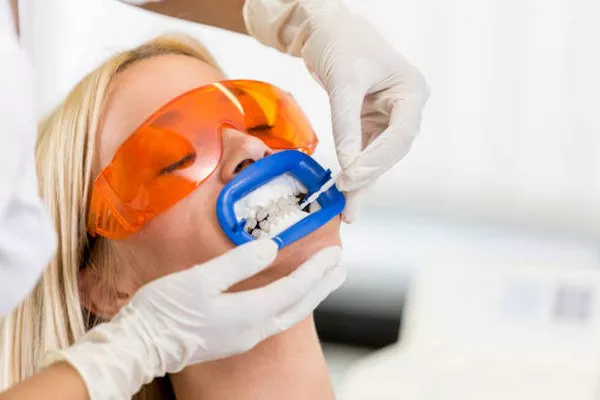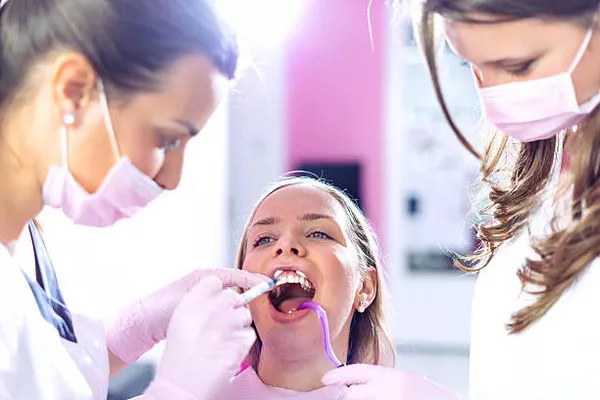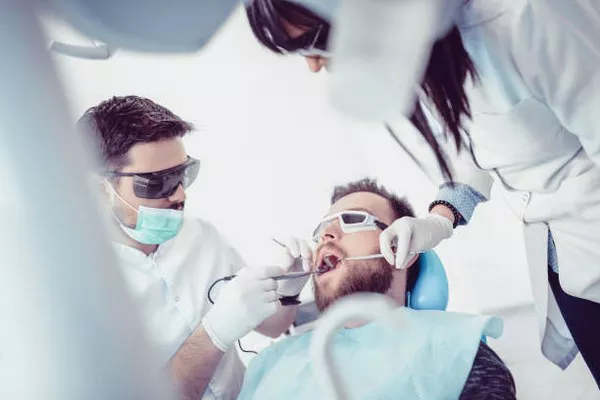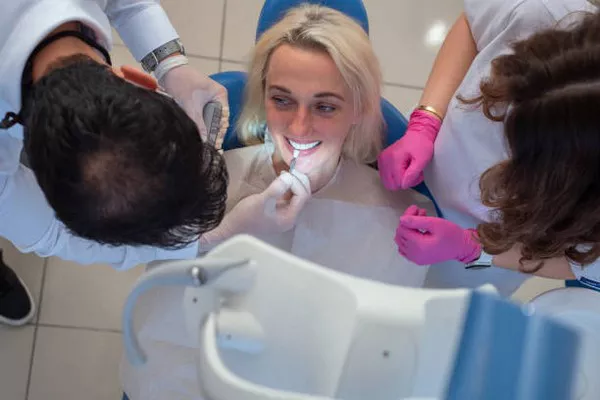Tooth discoloration can be a source of frustration and self-consciousness for many individuals. It can occur for various reasons, including extrinsic factors such as staining from food, beverages, and tobacco, as well as intrinsic factors that originate within the tooth structure itself. Intrinsic stains, particularly those that lead to permanent yellowing, can be more challenging to address.
Intrinsic stains develop when the inner structure of the tooth, known as dentin, becomes discolored or darkened. This can occur due to factors such as:
Trauma: Physical injury to a tooth can cause it to darken as a response to the trauma.
Dentinogenesis Imperfecta: A genetic condition that affects the formation of dentin, leading to discoloration and weakening of the teeth.
Medication Use: Certain medications, such as tetracycline antibiotics, can cause intrinsic staining if taken during tooth development.
Fluorosis: Excessive fluoride intake during tooth development can result in white or brown stains on the teeth.
Aging: As we age, the outer layer of enamel on our teeth wears down, revealing the naturally yellowish dentin underneath.
Unlike extrinsic stains, which may respond well to topical whitening treatments, intrinsic stains are more challenging to remove because they originate from within the tooth structure. Therefore, addressing permanent yellowing often requires more intensive whitening methods.
Professional Whitening Options
For individuals with permanent yellow teeth, professional whitening treatments performed by a dentist offer the most effective solution. These treatments typically involve the use of higher concentration peroxide gels that penetrate the enamel to target intrinsic stains.
One common professional whitening method is in-office bleaching, where a high-concentration hydrogen peroxide gel is applied to the teeth and activated with a specialized light or laser. The light or laser helps to accelerate the whitening process, resulting in noticeably brighter teeth in a single visit.
Another option is take-home whitening kits provided by dentists. These kits contain custom-fitted trays and professional-strength whitening gel, allowing patients to whiten their teeth in the comfort of their own home. While take-home kits may take longer to achieve desired results compared to in-office treatments, they can still effectively lighten permanent yellow teeth with consistent use.
At-Home Whitening Kits
In addition to professional treatments, there are numerous over-the-counter whitening products available for at-home use. These include whitening toothpaste, strips, gels, and kits with LED lights. While some of these products may produce noticeable results, they often contain lower concentrations of whitening agents compared to professional treatments.
Whitening kits with LED lights claim to enhance the whitening process by accelerating the breakdown of peroxide gel. However, the effectiveness of these kits can vary, and they may not produce results comparable to professional treatments. Additionally, without professional supervision, there is a risk of overuse or misuse, which can lead to tooth sensitivity or damage to the enamel.
see also: How to Get Rid of Yellow Braces Bands
Safety and Risks
When considering any whitening method, it’s essential to prioritize safety and be aware of potential risks. Professional whitening treatments overseen by a dentist are generally safe when performed according to their instructions. However, some individuals may experience temporary tooth sensitivity or gum irritation following treatment.
Over-the-counter whitening products also carry potential risks, particularly if used incorrectly or excessively. Abrasive toothpaste or whitening strips can wear down enamel over time, leading to increased tooth sensitivity and even tooth damage. It’s essential to follow the manufacturer’s recommendations and consult with a dentist if experiencing any adverse effects.
Longevity of Results
The longevity of whitening results varies depending on factors such as individual oral hygiene habits, dietary choices, and lifestyle factors. In general, professional whitening treatments can provide results that last anywhere from several months to a few years.
To prolong the effects of whitening, it’s essential to practice good oral hygiene, including brushing twice a day, flossing regularly, and using a fluoride mouthwash. Additionally, avoiding foods and beverages that are known to stain teeth, such as coffee, tea, and red wine, can help maintain a brighter smile for longer.
Maintenance
After undergoing whitening treatment, it’s crucial to establish a maintenance routine to preserve the results. This includes:
Regular Dental Check-ups: Schedule routine dental visits for professional cleanings and exams to ensure optimal oral health.
Avoiding Staining Agents: Limit consumption of foods and beverages that can stain teeth, or rinse with water after consumption to minimize staining.
Good Oral Hygiene: Brush teeth at least twice a day with a fluoride toothpaste and floss daily to remove plaque and prevent new stains from forming.
Whitening Touch-ups: Consider periodic touch-up treatments to combat gradual staining and maintain a bright smile.
By incorporating these practices into your daily routine, you can help prolong the effects of whitening and keep your smile looking its best.
When to Seek Professional Help
While over-the-counter whitening products may be effective for mild surface stains, deeper and more persistent discoloration, especially in cases of permanent yellowing, may require professional intervention. If at-home remedies fail to produce satisfactory results or if you experience severe discoloration, it’s essential to consult with a dentist.
A dentist can assess the underlying cause of tooth discoloration and recommend appropriate treatment options, which may include professional whitening, veneers, or other cosmetic procedures. Additionally, certain underlying dental issues, such as cavities or gum disease, may need to be addressed before pursuing whitening treatment to ensure optimal results.
see also:How to Get White Teeth from Yellow Teeth
Costs and Insurance
The cost of whitening treatments can vary depending on the method chosen and the complexity of the case. In-office professional whitening treatments tend to be more expensive than at-home options due to the expertise involved and the use of specialized equipment.
On average, in-office whitening treatments can range from a few hundred to over a thousand dollars per session, while take-home kits may cost less but require multiple applications for desired results. Dental insurance typically does not cover elective cosmetic procedures like teeth whitening, so patients should be prepared to pay out of pocket for treatment.
Alternative Remedies
While there are many anecdotal claims about the effectiveness of natural remedies for whitening teeth, scientific evidence supporting their use is limited. Some alternative remedies that are often mentioned include:
Oil Pulling: Swishing coconut oil or other oils around in the mouth to remove bacteria and toxins.
Baking Soda: Brushing teeth with a paste made from baking soda and water to remove surface stains.
Activated Charcoal: Using activated charcoal powder to absorb stains and toxins from the teeth.
While these methods may produce modest whitening effects or promote overall oral health, they are unlikely to significantly lighten permanent yellow teeth. It’s essential to approach alternative remedies with caution and consult with a dentist before trying them, especially if you have underlying dental issues or concerns.
Conclusion
Addressing permanent yellow teeth requires an understanding of the underlying causes of tooth discoloration and careful consideration of the most appropriate whitening methods. While professional treatments offer the most effective and long-lasting results, at-home options can provide satisfactory outcomes for milder cases. Prioritizing safety, maintaining good oral hygiene, and seeking professional guidance when needed are key to achieving and preserving a brighter, healthier smile.
FAQs About Yellow Teeth and Whitening
1. How do you get rid of yellow teeth permanently?
Getting rid of yellow teeth permanently typically involves a combination of good oral hygiene practices and professional dental treatments. Brushing your teeth regularly with a whitening toothpaste, avoiding staining foods and beverages, and visiting your dentist for regular cleanings can help prevent and reduce yellowing over time. For more stubborn discoloration, professional whitening treatments like in-office bleaching or custom whitening trays may be recommended.
2. Can permanent yellow teeth be whitened?
Yes, even permanent yellow teeth can be whitened through various dental treatments. While the degree of whitening may vary depending on the cause and severity of the discoloration, professional whitening procedures like in-office bleaching or at-home whitening kits provided by your dentist can help improve the appearance of yellow teeth. It’s essential to consult with a dental professional to determine the most suitable whitening options for your specific situation.
3. Why are my teeth forever yellow?
Several factors can contribute to permanently yellow teeth, including genetics, aging, lifestyle habits, and certain medical conditions. Genetics can determine the natural color of your teeth and may predispose you to yellowing over time. Additionally, habits like smoking, consuming staining foods and beverages (such as coffee or red wine), and inadequate oral hygiene can cause teeth to become discolored. Certain medications and medical conditions can also impact tooth color. Understanding the underlying cause of your yellow teeth can help determine the most effective whitening treatments.
4. Why won’t my yellow teeth whiten?
Several reasons may prevent yellow teeth from whitening effectively, including the severity of discoloration, underlying dental issues, and the type of whitening treatment used. Deep intrinsic stains, which occur within the tooth structure, may be more challenging to lighten with over-the-counter whitening products alone and may require professional dental interventions like bleaching or veneers. Additionally, existing dental problems such as cavities, enamel erosion, or gum disease can interfere with the whitening process. Consulting with a dentist can help identify any underlying issues and recommend appropriate whitening solutions tailored to your needs.
You Might Be Interested In































